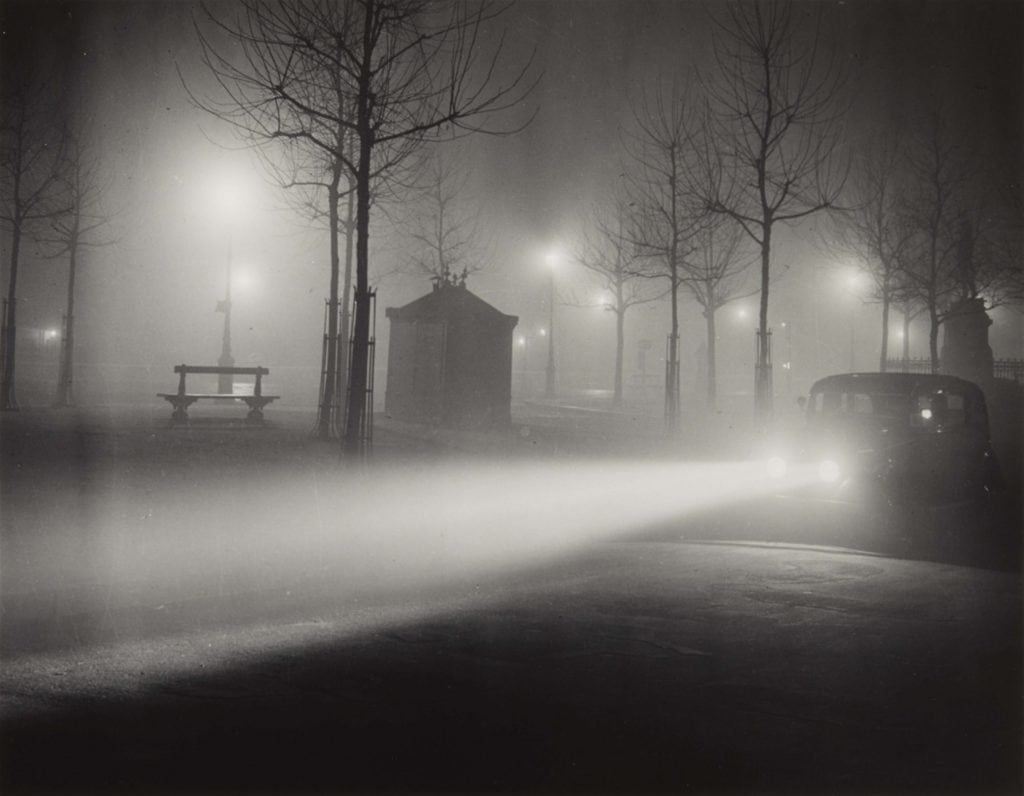
Brassaï is one of those photographers whose work had an immediate and profound effect on me. His dreamlike nocturnal street photography and sharply observed portraits of life after dark provide a unique set of images that is as close to a time slip into 1930s Paris as most of us will ever encounter.
Paris de Nuit
His most famous work (Paris de nuit, 1933 and Voluptés de Paris 1935) opened up a dark realm that had only been captured by painters before. He was not the first to shoot at night – Alfred Stieglitz amongst others had worked at night previously, but he was the first to produce a substantial body of work. After Paris by Night, other photographers took to sustained nocturnal photography – Bill Brandt captured London in the late 1930s (it was Brassaï’s publisher who commissioned Brandt night time work) and Weegee did the same in New York in the 1940s.
“Night does not show things, it suggests them. It disturbs and surprises us with its strangeness.”
As a self-taught pioneer of night photography in his adopted home of Paris (he was a Hungarian émigré), Brassaï faced the relatively new photographic challenges of working at night, equipped as he was with a Voigtlander 6.5 x 9cm camera, slow f4.5 lens and a wooden tripod. His atmospheric landscape shots needed long exposures and were subjected to excessive contrast from street lights. Ingeniously, he used the varying lengths of his smokes, inevitably including a Gauloise, to time his exposures. He also carried copies of his work to explain his late night activities to local law enforcement. An article on Imaging Resource describes his technique:
Using his training as a painter, Brassaï framed his shots so that small areas of light pierced large areas of blacks and shadows. Light reflected in wet streets and diffused by fog, would define shapes within the dark. This contrast gave his printed images richness and depth and he called these prints his “little boxes of night.”
Ground-breaking though his night photography was, Brassaï had a wide palette. His work ranges from surgically precise photojournalism to avant garde dreamscapes. He combined the eye of an expert people watcher with a painterly ability to shade and tone his work with beautifully diffused light. A polymath, he was a journalist, artist and sculpturer as well as a master photographer. He cited Henri de Toulouse-Lautrec as an influence and was friends with Dali, Picasso and Matisse.
Curiously, Brassaï started out with a dim view of photography, comparing it unfavourably to the art he originally pursued, but it became a requirement of his journalistic assignments, and having seen the beauty of Paris at night he became determined to capture it – defining night photography in the process. He was influenced by his friend and fellow Hungarian André Kertész, a pioneer of photojournalism, of whom Henri Cartier-Bresson said: “Each time Andre Kertész’s shutter clicks, I feel his heart beating.”
A walk on the wild side
Brassaï’s walks in the Montparnasse district of Paris brought him into contact with a night time cast of prostitutes, street toughs, lamp lighters, transvestites and pleasure seekers. He is most famous for the ground-breaking and gritty images he captured of those night folk. In his own words: “Night does not show things, it suggests them. It disturbs and surprises us with its strangeness.” As he was well connected, Brassaï’s work also includes images of high society, including ballet, opera, artists (including Picasso) and the intelligentsia. Consequently his work documents 1930’s Paris from the most marginalised to high society. A New York Times Article published in 1984, the year he died, captured perhaps the most celebrated aspect of his unique vision:
A Transylvanian transplanted to Paris, he managed in the 1930’s to capture aspects of French life that had never before submitted themselves to the camera, and to do so with a directness and vigour that is a hallmark of greatness in the medium. No doubt as a émigré he saw Paris more acutely than most of its natives, but he also was able to penetrate its darker demimonde because of a relentless passion for the forbidden and deep sympathy with the outcast.
Brassaï, like William Klein and Fan Ho (all hugely influential) was an outsider in the environment he chose to shoot in and that contributes, as noted above, to his unique perspective. Although most famous for night photography and Parisians of the night, Brassaï’s work is multi-faceted. Beyond his night time shooting he used the soft, diffuse light of fog and the muted tones of rainy days to capture the essence of Paris and its inhabitants just as beautifully in daylight. He was also a connoisseur of graffiti. Day or night, high society or underground, documentary or pictorial, Brassaï’s eye captured it all.